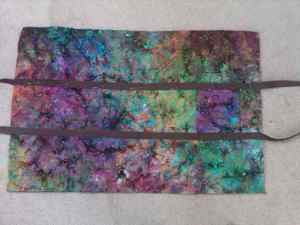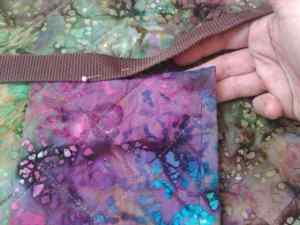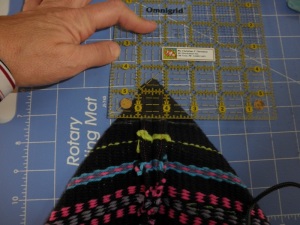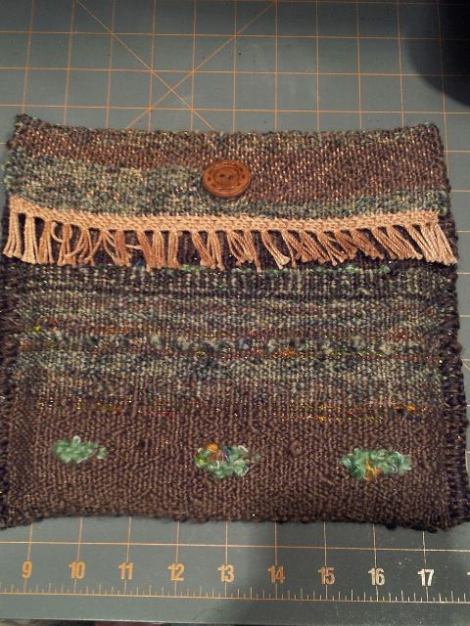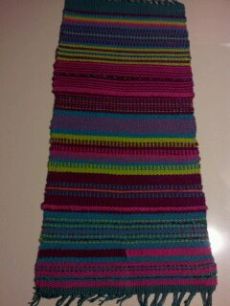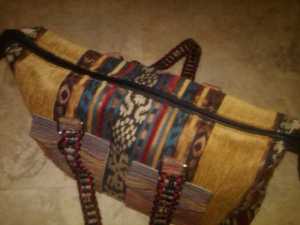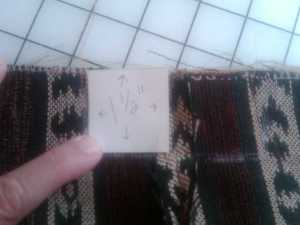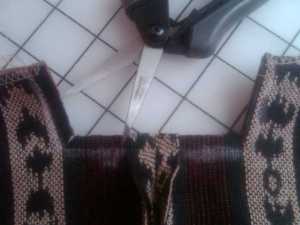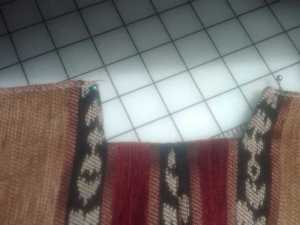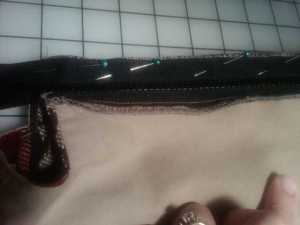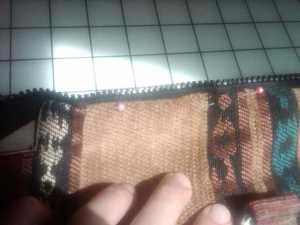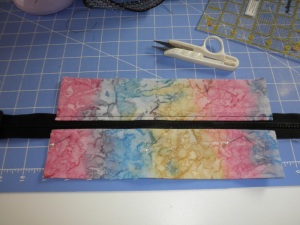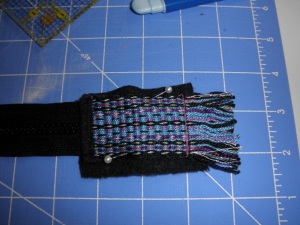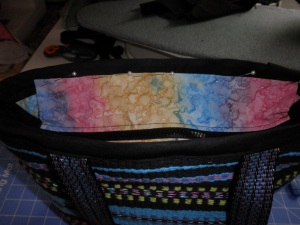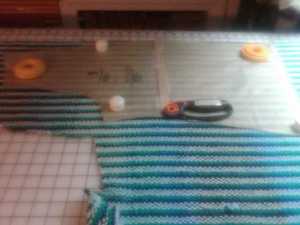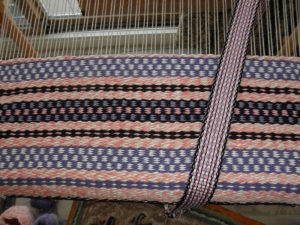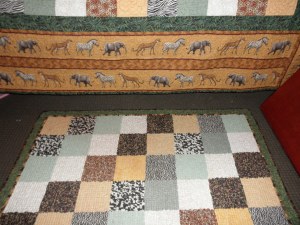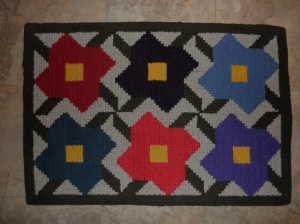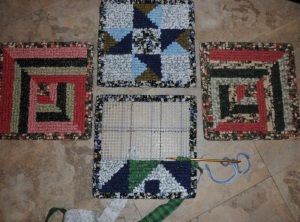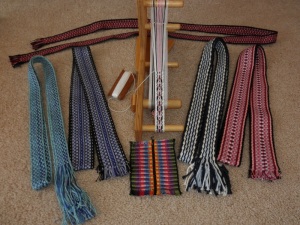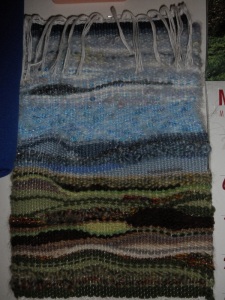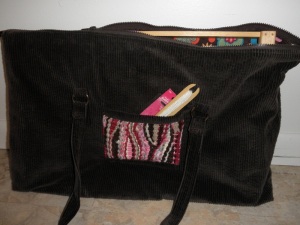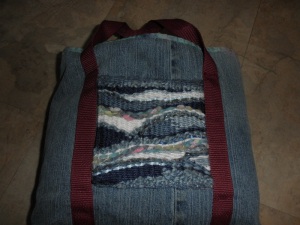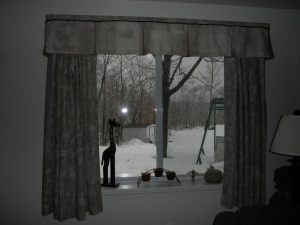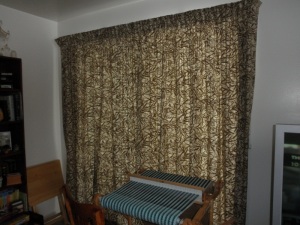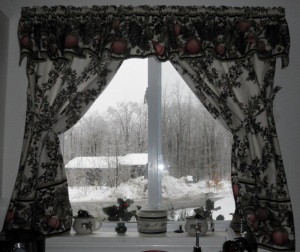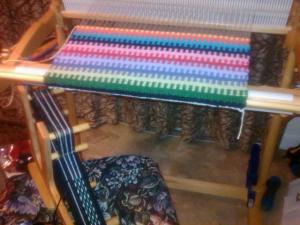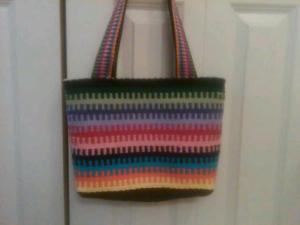Can you ever have too many tote bags? Of course not! Depending on what you choose for size and fabric, this simple tote can be used for groceries, toys, knitting projects…well, you get the idea.
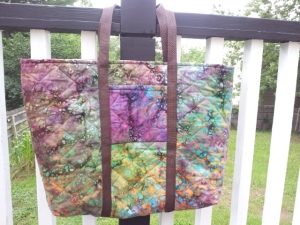 Fabric choices: For the easiest project, buy pre-quilted fabric from your local sewing/craft store. Your bag will have some firmness and a pretty contrasting lining. For two good-size totes, I bought 1/2 yard of 60″ fabric. Make sure to keep the design of the fabric in mind when purchasing. I only needed 1/2 yard because I knew I could fold the 60″ piece, so I could cut two bags at 18 x 30. If your fabric design runs obviously lengthwise on the fabric, you could buy 1 yard and make three bags cut 18 x 30, with a little fabric left over. (If that was too much math and you feel your head exploding, just buy 1/2 yard of 60″ fabric that doesn’t matter which way it goes and move on to the fun stuff.)
Fabric choices: For the easiest project, buy pre-quilted fabric from your local sewing/craft store. Your bag will have some firmness and a pretty contrasting lining. For two good-size totes, I bought 1/2 yard of 60″ fabric. Make sure to keep the design of the fabric in mind when purchasing. I only needed 1/2 yard because I knew I could fold the 60″ piece, so I could cut two bags at 18 x 30. If your fabric design runs obviously lengthwise on the fabric, you could buy 1 yard and make three bags cut 18 x 30, with a little fabric left over. (If that was too much math and you feel your head exploding, just buy 1/2 yard of 60″ fabric that doesn’t matter which way it goes and move on to the fun stuff.)
Straps: Next, you can always make straps, but if you buy nylon or cotton webbing, your straps will be almost indestructible (except not puppy-proof — makes the perfect chew toy, just FYI). Since I was making a large bag, I bought 4.5 yards of 1″ webbing for each bag. Remember, it’s going to travel twice the height of your bag, plus enough for handles.
Gather your rulers, your scissors or rotary cutter, matching thread and turn on some tunes. It’s SEW TIME!!
Cutting: With the right side up, trim your fabric to the rectangle size you want. Mine was 17″ x 28″ by the time I straightened out the edges. Leave the fabric laying flat and mark the center points on all four sides. (I use chalk or crayon.) On the shorter sides, measure and make a mark at 3″ on either side of the center point. Now take a long ruler, using those markings, draw a line from one end to the other of your piece. You will be using this to line up your straps. Look at pictures below to see why.
I decided to add a pocket and had some extra fabric, so I cut a 6″ x 7″ square of the prequilted fabric.
Edge finishing: (I know, it’s weird to “finish” before you’ve even started.) If you have a serger, you can “finish” all the edges by serging around both pieces with a three-thread edge.
On a traditional sewing machine, zig zag around the edges, letting your needle fall off the outside edge. This is bulky fabric, and you’re going to have to hang on as you go around. This doesn’t have to look perfect. You’re just getting rid of the “hangy” threads and squishing the quilting together. You can use a long pin, an awl, or your seam ripper held in your right hand, pressing the fabric into submission as it goes under the presser foot.
Optional pocket: If you’re putting on a pocket — and I really think you’ll want to — now is the time to put it on. If you’re using prequilted fabric, you might want to use the contrasting side as the outside of your pocket. Either way, fold down 1″ (toward what you have chosen as the inside of your pocket) on one of the 6″ sides to make a hem and stitch across. On your large rectangle, place the pocket where you want it to be — usually 3 or 4″ from the narrow end, centering it between your strap marks. It should overlap the markings by about 1/2″ on either side. Draw a placement line on your bag along the bottom of the pocket. Now, flip the pocket down, so the bottom of pocket is on your placement line. Stitch across the pocket bottom, and then flip back up into place, enclosing your seam inside the pocket. Put a pin in the center of the pocket for now so it stays lined up over strap markings.
Straps: Decision time. Just for testing, safety pin your strapping into a large loop. Lay your strap on your fabric, with the pinned piece where your hand will hold it. (You won’t leave it like this later) Then lining up the inside edge with your markings, pin the strap in a few places all around the bag. Pick up your rectangle, fold it in half and try out the strap. Adjust the pinned loop till you have the length you like. Now, leaving the end of the strap pinned where you want the length, unpin your strap from the bag. If you have a nylon strap, now that you know the exact length, you can cut it and fuse the ends over a flame. If it’s cotton, zigzag over ends. Overlap and sew the ends of the loop together where you pinned it, being very careful not to twist the strap. Hold the loop with the sewn part at one end and mark the opposite end of your loop.
Now you’re ready to seriously pin the strap to the bag. Using the center markings as guides, place the sewn end and the opposite marked end at the center bottom of your bag, with the inside strap edge following along the strap markings. As you pin, think about how you are going to be putting the fabric through your machine and how easily you will be able to pull the pins. (Once you do it backwards, you’ll remember that step next time.)
Before you start stitching, pick up your bag, fold it in half and double-check that your handles are equal and that your pocket is sewn right side up. (Yes, I have sewn a pocket upside down before. Your seam ripper will be your frenemy.)
You’re almost there! Sew close to both edges of the straps, stopping 2″ from the ends of your bag. When you stop, leave your needle down, and turn the bag and sew across the top of the strap before continuing down the other edge of strap. I even backspace across a couple times as this is the part of your strap that will need strength. If you’re confident you can sew straight, you can use a thread that contrasts your strap for added detail. If your sewing is still a little wonky, match the thread closely to the strap — a little darker shows less than a little lighter in matching thread.
After you’ve stopped to admire your wonderful sewing job, fold your bag in half, right sides together. Lay it flat and pin both side edges. I sew this part from the top to the bottom. You can backstitch at the beginning of your seam, but it’s not terribly important because you’ll be hemming it in a second.
Hem top: With the bag still wrong side out, fold over the top edge over one inch (toward what will be the bag’s inside) and pin. You’ll be sewing around the top in a circle, so if your machine has a free arm, this is a good time to try it out. Stitch around.
Squaring off bottom: Now, we create a bottom to the bag, by squaring up the bottom corners.
With the bag still inside out, lay bag down, and align one side seam with the center bottom of the bag. This will create a triangle shape. Draw a line across the base of the triangle. Depending on the size of your bag, this could be 2-3″ long. Pin and stitch across that line twice. Repeat on opposite side. I then cut the triangle point and serge or zigzag the edge. Sometimes I take the point and tack it to my side seam. (Especially with my hand-woven fabrics.)
Turn your bag right side out and do a happy dance!
Sample drapery fabrics also make great totes and are often very inexpensive. Recycled jeans are another great option. You might have to piece fabrics to get the right size, and you may also want to fuse or sew a piece of lining fabric to your rectangle depending on the weight of your exterior fabric. If you choose to sew the lining on, just place the lining fabric and exterior pieces right sides together, sew around leaving a hole on the side for turning, then turn right side out, and top stitch over your opening. Then follow directions above, skipping the “edge finishing.” Your inner seams and top hems will be nicely finished when your bag is complete.
Make time today to make something beautiful!

